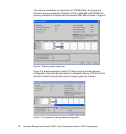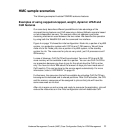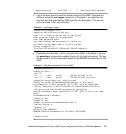Hardware Management Console (HMC) Case Configuration Study for LPAR Management 11
HMC sample scenarios
The following examples illustrate POWER5 advance features.
Examples of using capped/uncapped, weight, dynamic LPAR and
CoD features
Our case study describes different possibilities to take advantage of the
micropartitioning features and CoD assuming a failover/fallback scenario based
on two independent servers. The scenario does not address a particular
clustering mechanism used between the two nodes. We describe the operation
by using both the WebSM GUI and the command line interface.
Figure 4 on page 12 shows the initial configuration. Node nils, a partion of a p550
system, is a production system with 2 CPUs and 7 GB memory. We will force
node nils to fail. Node julia, also a partion of a p550 system, is the standby
system for nils. The resources for julia are very small, just 0.2 processors and 1
GB memory.
In case of takeover, CoD On/Off will be activated. Two more CPUs and 8 GB
more memory will be available to add to a partion. You can use CoD On/Off for
our procedure because you have to pay for the actual days the CoD is active
only. You have to inform IBM about the amount of days you have made use of
CoD monthly. This can be done by the service agent automatically. For more
information, refer to “APPENDIX” on page 40.
Furthermore, the resources that will be available by activating CoD On/Off can
be assigned to dedicated and to shared partitions. After CoD activation, the CPU
and the memory resources will be assigned to julia so that julia will have the
same resources as nils had.
After nils is again up and running and ready to reacquire the application, julia will
reduce the resources as in the initial configuration and will deactivate CoD.


















